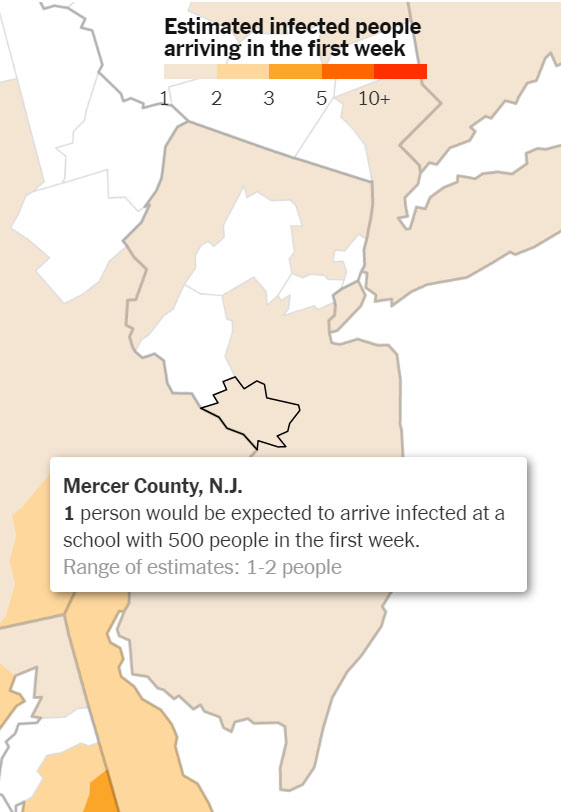I& #39;m thinking quantitatively about the risk to kids and grown-ups as schools reopen. Seems to me that the only place this can happen safely is the Northeast - and that wherever we attempt re-opening, nasal-swab testing will reduce the risk by a factor of ~4.
Calculations follow:
Calculations follow:
First, let& #39;s consider an example close to home: Mercer County, New Jersey. At the current case rate, in a 500-person school, without any preventive measures, 1-2 children or adults will show up with a live coronavirus infection. https://www.nytimes.com/interactive/2020/07/31/us/coronavirus-school-reopening-risk.html">https://www.nytimes.com/interacti...
Obviously we& #39;d like to mitigate that. The best case is to prevent him/her from showing up in the first place.
One way is symptom tracking (fever, sore throat, loss of smell/taste). But a recent estimate from multiple studies suggests that ~20% of infecteds never show symptoms.
One way is symptom tracking (fever, sore throat, loss of smell/taste). But a recent estimate from multiple studies suggests that ~20% of infecteds never show symptoms.
Combine that with the fact that presymptomatic people are contagious for several days. I would hazard that ~25% of contagious people won& #39;t be detected by symptom screening.
In other words, on Day 1, 0.25-0.5 cases will show up somewhere in our hypothetical Mercer County school.
In other words, on Day 1, 0.25-0.5 cases will show up somewhere in our hypothetical Mercer County school.
Are we OK with this? Maybe we can contain the risk by forming cohorts within the school. But the way kids mix it up in a school, that seems very difficult.
Also, how often will new infections show up?
Also, how often will new infections show up?
(envelope calculation here, subject to modification)
Assume an infection duration of 2 weeks.
If there are 0.25-0.5 cases at any given moment, then we should expect one new case every (2 weeks)/(0.25-0.5) = once every 4 to 8 weeks.
Can we catch them before they get to school?
Assume an infection duration of 2 weeks.
If there are 0.25-0.5 cases at any given moment, then we should expect one new case every (2 weeks)/(0.25-0.5) = once every 4 to 8 weeks.
Can we catch them before they get to school?
Enter nasal-swab testing, whether by RT-PCR or antigen. These tests are like lacrosse sticks, where the net is the test and the ball is the kid or grown-up. Catch the ball, stop the infection.
None of this primitive symptom-tracking stuff.
None of this primitive symptom-tracking stuff.
If we nasal swab tested every single person in our hypothetical low-infection school every 2 weeks, we could eliminate most of the risk.
That gets expensive. To reduce the cost, test in pools. 1 homeroom = 1 pool.
https://www.nytimes.com/interactive/2020/07/27/upshot/coronavirus-pooled-testing.html
A">https://www.nytimes.com/interacti... few thousand $ per round of testing.
That gets expensive. To reduce the cost, test in pools. 1 homeroom = 1 pool.
https://www.nytimes.com/interactive/2020/07/27/upshot/coronavirus-pooled-testing.html
A">https://www.nytimes.com/interacti... few thousand $ per round of testing.
If we don& #39;t test, then school-reopening becomes a form of Russian roulette. In the Mercer County example, there& #39;s a 1 in ~100 chance of an infected kid or adult in any given homeroom, every single week.
What about places with a higher case rate?
First thought: don& #39;t do it.
What about places with a higher case rate?
First thought: don& #39;t do it.
Instead of one case every 4-8 weeks, we& #39;re talking a new case every week. That& #39;s why you& #39;re seeing stories like what happened in Georgia and Indiana - a new case on the very first day of reopening.
If resources permit, my recommendations would be:
1) only reopen in places where the expected rate of new cases is <1 per week;
2) do pooled, *rapid turnaround* nasal-swab testing of the entire school., every 2 weeks;
3) otherwise, go all-remote.
1) only reopen in places where the expected rate of new cases is <1 per week;
2) do pooled, *rapid turnaround* nasal-swab testing of the entire school., every 2 weeks;
3) otherwise, go all-remote.
A key element of this is rapid turnaround. This *cannot* be done by national laboratories, whose 2-week turnaround time is basically useless.
This would requires local testing capability, with turnaround of a few days - or faster. Around here, some urgent-care centers do that.
This would requires local testing capability, with turnaround of a few days - or faster. Around here, some urgent-care centers do that.
That& #39;s my initial take, with just envelope calculations.
Major disclaimer: I don& #39;t work in public health. I& #39;m just trying to put concrete detail on what we are all facing.
/end
Major disclaimer: I don& #39;t work in public health. I& #39;m just trying to put concrete detail on what we are all facing.
/end
P.S. One commenter suggests saliva testing. Possible...the necessary criteria would are rapid turnaround, and scalability of cost, for example by pooling samples.

 Read on Twitter
Read on Twitter


